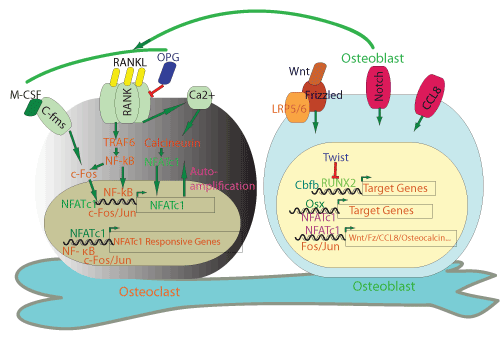
Osteoclast requires M-CSF for survival and RANKL for differentiation from its precursor. Osteoblast produces RANKL and M-CSF to support osteoclasts, and OPG to inhibit osteoclasts as a negative feedback mechanism. OPG inhibits osteoclast differentiation by blocking the binding of RANKL to RANK, acting as a decoy receptor. RANKL-RANK activates NFATc1 pathway by inducing low amplitude calcium oscillation to activate calcineurin phosphotase activity and by inducing NFATc1 autoamplification in transcription. The activation of NFATc1 promoter requires c-Fos and NF-κB. RANK activates NF-κB through TRAF6. In Osteoblast, RUNX2 and Osx are essential for its differentiation. RUNX2 requires Cbfβ for sufficient DNA binding. Osx cooperates with NFATc1 to activate target genes. NFATc1 activates its target genes in osteoblast including Wnt4, Frizzled9 (Fz), CCL8, and osteocalcin, and suppresses the expression of Wnt inhibitory genes secreted frizzled-related protein 2 (sfrp2) and Dickkopf 2. Twist, as a negative regulator of osteoblast, binds to RUNX2 and inhibits its ability to activate target genes. Notch and CCL8 and many other proteins not described here also regulate osteoblasts [80-82].